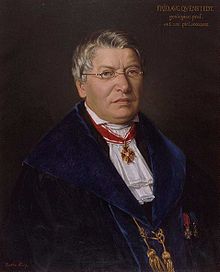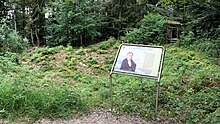Friedrich August Quenstedt


Friedrich August Quenstedt , from 1862 von Quenstedt , (born July 9, 1809 in Eisleben , † December 21, 1889 in Tübingen ) was a German geologist , paleontologist , mineralogist and crystallographer .
life and work
Friedrich August Quenstedt was the son of a former Prussian sergeant who later became a gendarme in the Kingdom of Westphalia and finally a hospital administrator in Halberstadt and who died in 1815 of typhus . His mother was the daughter of a forester from Neinstedt . After his father's death, he grew up with his uncle, who made it possible for him to attend high school in Eisleben. From 1830 he studied "Geognosy" and mineralogy with Christian Samuel Weiss in Berlin and had contacts with Leopold von Buch . He also heard lectures from Georg Wilhelm Friedrich Hegel and cared for him in 1831 as part of the student nursing service on the eve of his death from cholera. A college friend was the astronomer Johann Gottfried Galle . In 1833 he became custodian at Weiss and gave his first lectures in Berlin. The first scientific publication took place in 1835 and in 1836 he received his doctorate with a palaeontological thesis on nautiloids (De notis nautilearum primariis) and in 1837 he completed his habilitation in Berlin. In 1837 he took over the newly created chair for mineralogy and geognosis at the Eberhard Karls University of Tübingen . He established the still young geology as an independent branch of science in the Kingdom of Württemberg . He held the chair for 52 years. His term of office went down in the annals of the Geological Institute as the Quenstedt era . His main research interests were primarily fossils and their use in stratigraphy . Through his own collections, but also through purchases, he built up an important fossil collection in Tübingen that is suitable for research and teaching . In 1842 the collection already had 30,000 exhibits. A large part of this also contributed to the Öschingen farmers who collected ammonites for Quenstedt . In 1842 he coined the term landscape landscape , which is still used internationally today .
His main merit is intensive research into the Jura formations of the Swabian Alb . Like the Englishman William Smith, he used index fossils for geological age determination . The Quenstedt structure of the fine layers of the Jura , which was only replaced by an international structure in 1973 , is named after him . The paleontological standard work Der Jura , which he published in 1858, also comes from his pen . Until shortly before his death, he produced an extensive set of tables about the ammonites of the Swabian Alb. He knew how to interest a wide audience in fossils through an entertaining style of lecturing. However, he hardly looked beyond Swabia. His fossil collection can still be viewed in the Geological Institute of the University of Tübingen and can be used to compare your own findings. He was also in Nusplingen and discovered the plate limestone .
From 1862 he was involved in the creation of the geological survey of Württemberg and ten maps were made by him between 1865 and 1881.
One of his more important students was the paleontologist Albert Oppel . His grandson Werner Quenstedt (1893–1960) worked in the 1930s and 1940s as a geologist and paleontologist at the Friedrich-Wilhelms-Universität in Berlin.
Quenstedt had expressed sympathy and antipathy and ignored people he disliked. He was a popular speaker at student meetings, but was strictly abstinent. Although the Fatherland Association for Natural History in Stuttgart certified that he had become a Swabian with every fiber of his life on his 50th anniversary as professor, his strong “Saxon” reminded him of his non-southern German origins, which also aroused hostility to him in the war of 1866 , and he also kept his fondness for home cooking.
In 1838 he married Caroline Christiane Auguste Stürmer in Tübingen, and after her early death her two sisters one after the other, who also died prematurely. His fourth marriage was in 1869, when he married Anna Sachse, who was the sister of his son-in-law, who was the pastor of Hechingen.
Ennoblement, honors

- 1856 Knight's Cross of the Order of Frederick .
- In 1862 Friedrich August Quenstedt received the Knight's Cross of the Order of the Württemberg Crown , which was associated with the personal title of nobility.
- In 1869 he was appointed a foreign member of the Bavarian Academy of Sciences .
- In 1886 he received the commentary cross of this order.
- In 1888 he was named after the newly discovered mineral quenstedtite .
- The Quenstedt-Gymnasium in Mössingen ( Tübingen district ) was named after Friedrich August Quenstedt .
- A monument on the Roßberg , one of the highest mountains in the Middle Swabian Alb , commemorates Friedrich August Quenstedt.
Fonts
- Method of crystallography. A textbook for beginners and experts. Osiander, Tübingen 1840. MDZ Munich
-
The seam mountains of Würtemberg. With special consideration for the Jura. Laupp, Tübingen 1843.
- Second edition increased with register and some improvements. Laupp, Tübingen 1851. MDZ Munich
-
Petrefact customer of Germany. Fues, Leipzig 1846–1884.
- First division
- First volume: The Cephalopods. Along with an atlas of 36 plates. 1846-1849. MDZ Munich
- Volume Two : The Brachiopods. Along with an atlas of 25 plates. 1871.
- Third volume: echinoderms (echinids). Along with an atlas of 25 plates. 1875.
- Fourth volume: Echinoderms (asterids and encrinids together with cysti and blastoids). Along with an atlas of 25 plates. 1876.
- Fifth volume: corals (sponges). Along with an atlas of 28 plates. 1878.
- Sixth volume: corals (tube and star corals). Along with an atlas of 42 plates. 1881.
- Seventh volume: gasteropods. Along with an atlas of 34 plates. 1884.
- First division
-
Handbook of petrefacts. 1st edition. With 62 boards and explanations. Laupp, Tübingen 1852.
- 2nd revised and enlarged edition. With 86 plates and 185 woodcuts along with their explanations. 1867.
-
Handbook of Mineralogy. With many woodcuts. Laupp, Tübingen 1855. MDZ Munich ; Digitized and full text in the German text archive
- Second improved edition. Laupp, Tübingen 1863.
-
The Jura. With 3 overview panels, 42 woodcuts and an atlas of 100 tabs.Laupp, Tübingen 1858.
- Atlas of the Jura. With 100 tables and 3 colored geological charts. Laupp, Tübingen 1858.
-
The ammonites of the Swabian Jura. Swiss beard, Stuttgart 1883–1888. Volume 1-3.
- I. Volume. The Black Jura (Lias). With an atlas of 54 plates. 1883-85.
- II. Volume. The brown Jura. With an atlas of 36 plates (plates 55–90). 1886. 1887.
- II. Volume. The white Jura. With an atlas of 36 plates (plates 91–126). 1887. 1888.
- Epochs of nature. With numerous woodcuts. Laupp, Tübingen 1861 MDZ Munich
Individual evidence
- ↑ Kurt Jaksch (2003): "Werner Quenstedt and his Achentaler Ampelsbach profile (Tyrol) with a contribution to the early development of lamellar lamellae". In: Jahrbuch der Geologische Bundesanstalt , Volume 143, Issue 1, pp. 45–55, Vienna, May 2003. PDF file
- ↑ a b Wolf von Engelhardt, Helmut Hölder, Mineralogy, Geology and Paleontology at the University of Tübingen 1977, p. 127
- ↑ Court and State Manual of the Kingdom of Württemberg 1877, p. 27
- ↑ Member entry by Prof. Dr. Friedrich August von Quenstedt (with picture) at the Bavarian Academy of Sciences , accessed on February 12, 2016.
- ↑ Court and State Manual of the Kingdom of Württemberg 1886, p. 25
- ↑ Quenstedt-Gymnasium
literature
- Müller, Theo (2009): For the 200th birthday of Friedrich August Quenstedt. In: » Blätter des Schwäbischen Albverein « 115, volume 2009, issue 6, pp. 8–9.
- Michael Montenari (2006): “Prof. Dr. Friedrich August von Quenstedt (1809-1889): A world-class paleontologist and his Swabian Jura ”. Pp. 17-20. In: Rademacher, R. [Ed.], “In a Sea Before Our Time - The Jurassic Sea 181 Million Years Ago”, 112 p .; ISBN 3-00-019570-X .
- Gerhard Lehrberger: Quenstedt, Friedrich. In: New German Biography (NDB). Volume 21, Duncker & Humblot, Berlin 2003, ISBN 3-428-11202-4 , p. 40 ( digitized version ).
- Dina Stahn (2002): The earth wrote her diary in stone. In: »Schwäbisches Tagblatt«, October 18, 2002, p. 25.
- Wolf von Engelhardt, Helmut Hölder: Mineralogy, Geology and Paleontology at the University of Tübingen, Mohr 1977.
- August Rothpletz: Quenstedt, Friedrich August . In: Allgemeine Deutsche Biographie (ADB). Volume 53, Duncker & Humblot, Leipzig 1907, p. 179 f.
- Oscar Fraas : Necrology of Professor Friedrich August Quenstedt , in: " Annual Books of the Association for Fatherland Natural History in Württemberg" , 47th year, E. Schweizerbart, Stuttgart 1891, pp. XXXIXf.
Web links
- Quenstedt structure ( Memento from September 8, 2003 in the Internet Archive )
- Literature by and about Friedrich August Quenstedt in the catalog of the German National Library
| personal data | |
|---|---|
| SURNAME | Quenstedt, Friedrich August |
| ALTERNATIVE NAMES | Quenstedt, Friedrich August von |
| BRIEF DESCRIPTION | German geologist and paleontologist |
| DATE OF BIRTH | July 9, 1809 |
| PLACE OF BIRTH | Eisleben |
| DATE OF DEATH | December 21, 1889 |
| Place of death | Tübingen |

